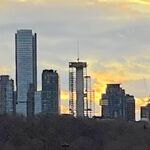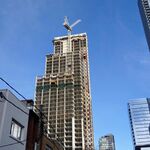Post articles
Link to article
Toronto growth limited to condominium boom
City's rate far from suburban areas such as Vaughan
Chris Wattie
National Post, with files from April Lindgren, CanWest News Service
Wednesday, March 14, 2007
Toronto's population continues to flee north and westward to the 905 region, according to census data released yesterday, but Statistics Canada also found pockets within the city where the growth rivalled that of the booming suburbs: corridors of condominiums along the waterfront, downtown and Highway 401.
"Those are virtually all condominiums: I don't know how you could squeeze 10% more people into those areas without building condos or apartments," said Dr. Larry Bourne, a professor of geography and planning at the University of Toronto. "It's pretty much a map of condo development in Toronto."
The city of Toronto's overall population growth was a lacklustre 0.9% according to the 2006 census, well below the national average of 5.4% and nowhere near the booming populations of communities such as Brampton (33.3%) or Vaughan (31.2%).
That showed the continued trend of flight to the suburbs, some of which recorded nearly unprecedented growth: Some of the fastest-growing communities were circled around Toronto, including Whitby (27.2%),Markham (25.4%) or Newmarket (12.9%).
Dr. Bourne said people have been moving away from the centre of the city for decades, driven by downtown housing prices and a strengthening economy in regions just outside the city. "It's a long-standing process," he said.
"Young families want to have a stand-alone, single family house and if you want that single-family house at a reasonable place you have to go outside the city."
The census data showed that Toronto and its burgeoning suburbs drove Ontario's growth of just over 750,000 people between 2001 and 2006, accounting for nearly 84% of the provincial population growth. The Ontario growth rate of 6.6% represented almost half of the population growth for the entire country.
When its 905 suburbs are factored in, the Toronto region grew to a total 5,113,149 people in last year's census -- the first time the area has passed the 5 million mark and more than enough to keep it firmly atop the Statistics Canada list of 33 major Canadian cities.
While the region's overall growth rate of 9.2% was well ahead of Montreal's 5.4% or the Vancouver area's 6.5%, it was out shadowed by Calgary, which grew by 13.4% and Edmonton's 10.4% population growth.
Overall, what Statistics Canada calls "census metropolitan areas" -- including the greater Toronto area -- grew at a rate of 6.9%, mainly in the six "millionaire's club" cities of Montreal, Vancouver, Ottawa-Gatineau, Calgary and Edmonton.
But the growth of Toronto's suburbs in this census period was more than double the national average -- 11.1% compared to 5.4% -- while the growth of Canada's central cities was only 4.2% on average.
Statistics Canada cited transportation corridors as key in the continuing move to the hinterlands beyond city boundaries. "In Toronto, the surrounding municipalities have grown up along a large network of expressways, including Highways 401 and 407 ... and Highways 400 and 404," the federal agency noted. "The development of efficient road or public transit infrastructure is a major factor in urban spread."
"The rapid growth of Brantford and Waterloo to the west, Barrie to the north and Clarington to the east suggests that urban spread in the region will continue."
In Barrie, the most recent statistics available show nearly one third of the city's working population commute to jobs outside the municipal boundaries.
"I have a job here in Barrie but last week I had to go into Toronto for a business meeting and got trapped in a winter storm," says Michael Prowse, a Barrie city councillor. "It took me seven hours to get home. It's usually 90 minutes with traffic. The congestion is getting worse and worse. It takes a toll on people's quality of life."
Toronto's sluggish population growth was not unique among Canadian cities: Montreal's population for example, grew by 2.3%, less than a third of the growth recorded by some of its suburbs and Vancouver's growth was outpaced by suburbs such as Surrey or Maple Ridge.
Dr. Bourne however said that much of Toronto proper is holding its own against the outflow of people to the suburbs. "There's a lot of pressure on the city, but the downtown for instance is doing pretty well," he said. "Don't forget: The city's population went up."
Within the city, several areas recorded growth of more than 10% including the prime strip of waterfront land opposite Toronto Island, stretches along Yonge Street downtown and clusters at Highway 401 and Yonge Street and to the west. "And that's virtually all new construction," Dr. Bourne said.
But he still expects the push outwards from the city to continue. "Visualize it as a wave: it just keeps going out and out and out," he said. "What the next step is I don't know, because pretty soon this expansion is going to run into the greenbelt."
"I suspect they'll just leap over it and look at communities even further out."
*****
Link to article
'Calredmonton' is ready to take on the country
Kevin Libin in Calgary
National Post
Wednesday, March 14, 2007
For the first time in their respective histories, both Calgary, above, and Edmonton have broken the seven-figure population barrier.
CREDIT: Leah Hennel, CanWest News Service
For the first time in their respective histories, both Calgary, above, and Edmonton have broken the seven-figure population barrier.
Is the world ready for Calredmonton? Or, perhaps Edcaldeer?
Whatever you call it, yesterday's census figures make a strong case that the stretch of people and prosperity along Alberta's Highway 2, running from Edmonton, via Red Deer to Calgary, is Canada's most dynamic region of growth.
And at the rate things are going, the area, some say, might morph into a virtually contiguous supercity. "It could happen in the future," said Frank Trovato, a University of Alberta demography professor. "These cities are already connected in more ways than just physical space. Communications, for example, commerce ... the cities are interconnected."
For the first time in their respective histories, Alberta's two major metropolises have broken the seven-figure population barrier, thanks to a provincial growth rate of 10.6%, double Canada's average. Stats Can calls the population milestone the "millionaire's club" but it's the billions in commerce moving up and down that highway -- $87- billion, comprising 7% of Canada's GDP -- that has workers swarming to the Calredmonton corridor.
Every day, 50,000 cars and trucks rumble up and down Highway 2. Drive the 300 kilometres from West Edmonton Mall to Stampede Park and you pass within 100 km of threequarters of Alberta's 3.3 million residents. It's a journey that not only begins and ends in two of Canada's fastest growing big cities, but passes through, or near, three of its most rapidly expanding midsize towns -- Red Deer (22% growth since 2001), Okotoks (46.7%) and Canmore (11.6%).
And with a 40% higher per capita GDP than other Canadian cities, it's no wonder TD Financial Group recently referred to the cluster around the Highway 2 ribbon as "Canada's Western tiger ... able to create the 'buzz' that other urban areas can only aspire to."
Calgary and Edmonton may be bitter hockey and football rivals who argue over which has the better quality of life and richest culture. But economically, their specialties mesh nicely, notes Todd Hirsch, chief economist at the Calgary-based Canada West Foundation.
"The two cities need to start thinking of themselves as one economic unit, rather than two cities that are competing constantly," he said. With the most head offices outside Toronto, Calgary is home base for the West's white collars, and its international airport is the main air transport hub in the region. Edmonton boasts robust manufacturing and refining sectors (it also has a fledgling hightech and biotech industry).
Hundreds of firms pumping gas and servicing the province's oil and gas sector fill in the space betwixt the two.
Although their downtowns may be a dreary three-hour drive apart, urban sprawl is spilling the two cities closer to each other, with bedroom communities sprouting between, as commuters seek smaller mortgages and bigger backyards.
Albertans may soon accept the same 90-minute drive to work that folks in Barrie, Ont., make to Toronto (the main reason that city was crowned this year the fastest growing in Canada). Eventually, where Calgary begins and Edmonton ends could become much blurrier, the way the drive from Toronto to Niagara appears as one vast suburb.
"You'll never see Edmonton and Calgary touch, but you could see, within our lifetime, everything along Highway 2, growing up to the point where it's one long stretch of urban density," Mr. Hirsch said.
The province has even mused about running a bullet train to cut the distance between Calgary and Edmonton to a single, white knuckled hour.
According to some estimates, that could goose the corridor with $6-billion in annual economic spinoffs. In 2004 it was provincial transport minister Ed Stelmach who met with Germany's Siemens AG to discuss a proposed magnetic-levitation train capable of doing 500 km/h. He's now the Premier.
With Alberta's spending still wildly out of control, the train may be off Mr. Stelmach's priority list for now, said Mr. Hirsch -- though it may only be a matter of time before the province considers it as an alternative to tripling Highway 2, which, as a two-lane road is currently operating close to capacity.
Either way, Albertans appear to have themselves their very own megalopolis, a term coined in the 1950s by geographer Jean Gottmann to describe a network of cities linked intimately by trade and labour. Mr. Gottman was thinking about the Boston-New York-Washington power circuit.
Today, you could say the same for Ontario's London-to-Whitby strip and there are dozens of others worldwide.
It is reason to celebrate when Canada births a new megalopolis: Economist Richard Florida last year observed that these dynamic regions produce in a nation "the bulk of its wealth, attracting a large share of its talent and generating the lion's share of innovation."
If the province's population growth continues at current rates, Alberta's megalopolis could encompass seven million talented and innovative souls by the time today's newborns are in their thirties.
Thankfully, with all that creative brainpower, some clever Albertan is certain to come up with a name for the area less painful to the ears than Calredmonton.





